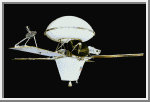 Contents |
What's New |
Image Index |
Copyright |
Puzzles |
Story Hobby/ |
Posters |
Search |
Contents |
What's New |
Image Index |
Copyright |
Puzzles |
Story Hobby/ |
Posters |
Search |
| ||||||||||||||||||

Courtesy of the Jet Propulsion Laboratory
Robots: Like Us!Spacecraft are complex, technological objects that have to function far from Earth in the harsh environment of space. They collect science data and send it to Earth. But, as strange as they appear to be, it can help to understand them if we compare spacecraft to ourselves! Think of the spacecraft as a living organism. As a lesson, this can be done in either of two directions. If the students are familiar with spacecraft they can be prompted with body parts and attempt to identify the analogous spacecraft part. This will work well if the students have a high quality picture of a modern spacecraft. Pictures of planetary spacecraft work the best since they have the least amount of their equipment hidden or encased in the body of the spacecraft. In the other direction, the students can be prompted with spacecraft parts and challenged to identify the relative anatomical part. This can lead to interesting discussions and differences of opinion ('Is electrical wiring more like blood vessels or nerves?'). The list below is not exhaustive but it sets the stage for a good follow-on activity. Identify a mission and a destination for a spacecraft and have teams of students design the spacecraft. They must be sure that the spacecraft has all the correct parts to fulfill critical functions. (It cannot have solar panels if it is going to Neptune, but it can have radioisotope thermoelectric generators (RTGs) if it is going to Mercury; however, including both takes up critical weight). Keep in mind, landers and "rovers" are spacecraft too. Rovers require ways to move and navigate. We human beings are built, and have to do certain things, to remain alive. The same is true for spacecraft.
Humans: Food/Water
Spacecraft: Solar panels (sunlight), radioisotope thermoelectric
generators (heat from the decay of radioactive
material; necessary in the weak lighting far from the
Sun), or batteries (stored energy)
Humans: Body/Torso
Spacecraft: "Bus" (The housing that holds the spacecraft
components and to which other devices are attached)
Humans: Brain
Spacecraft: Computer(s)
Humans: Nerves
Spacecraft: Electrical wiring
Humans: Skin
Spacecraft: Blankets (for temperature control [the spacecraft can
not sweat but it can have radiators or louvers to get
rid of excess heat] and meteorite protection)
Humans: Legs
Spacecraft: Rocket motors, fuel tanks (Because objects in motion
tend to remain in motion, most spacecraft do not need
to constantly burn fuel to move; their small rockets
[thrusters] are used to change their orientation in
space; a small amount of fuel lasts many years)
Humans: Blood vessels
Spacecraft: Fuel lines
Humans: Arms
Spacecraft: Booms
Spacecraft also have sense organs to explore the places that they visit. They must communicate the data back to Earth and receive new instructions.
Humans: Eyes (sense organs)
Spacecraft: Camera(s), spectrometers, magnetometers, other
science instruments
Humans: Neck
Spacecraft: Scan platform (which pivots around so that the
instruments can point in the desired direction
without reorienting the whole spacecraft)
Humans: Ears/mouth
Spacecraft: Communications antenna(e) (and receivers and
transmitters)
Can you think of any other comparisons? |
